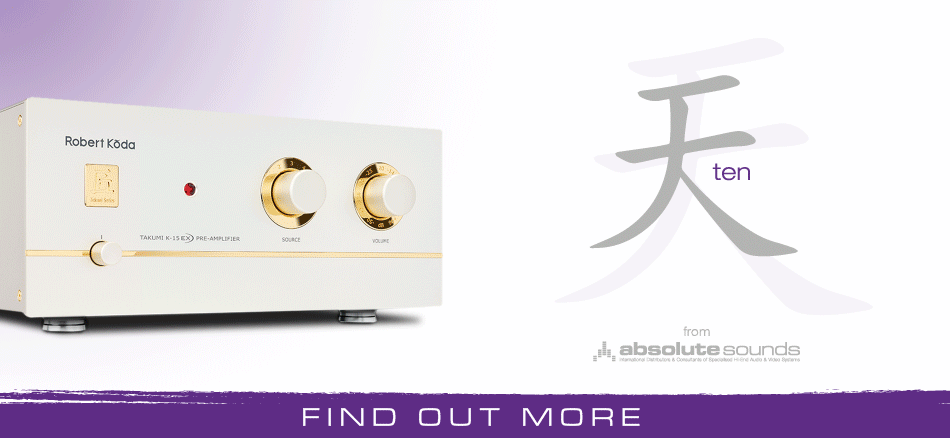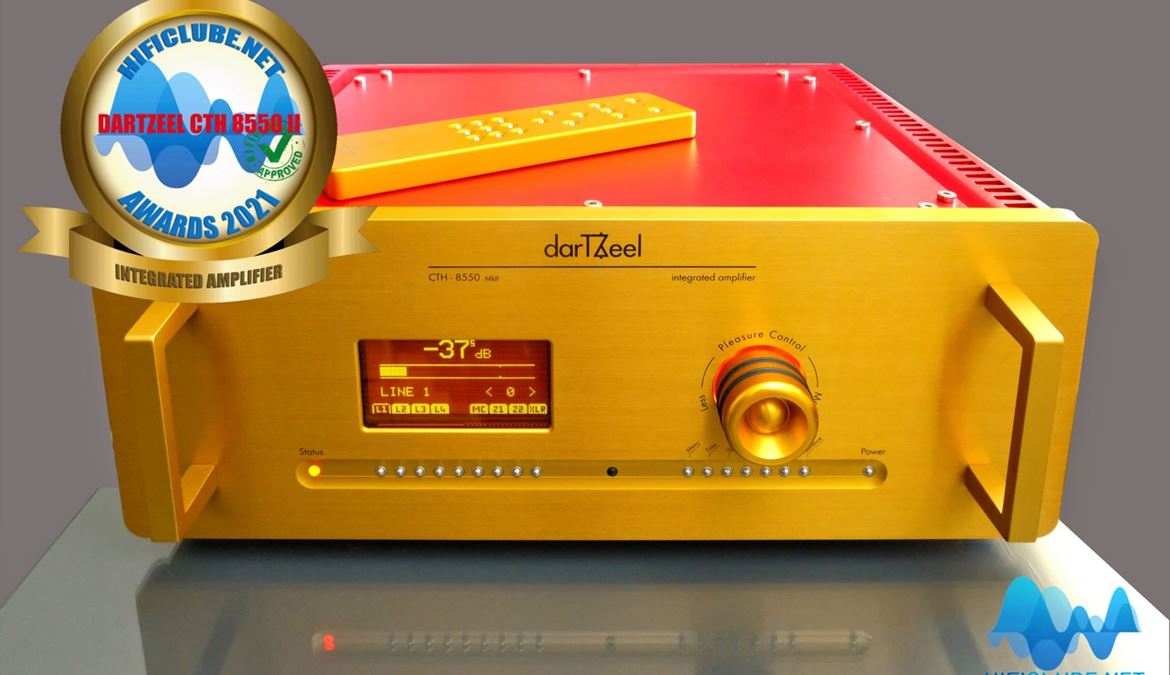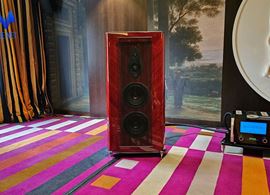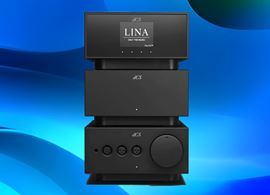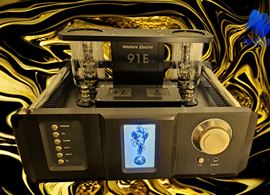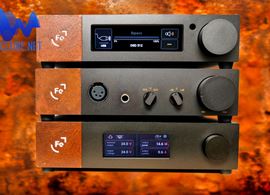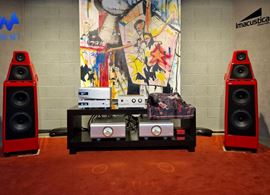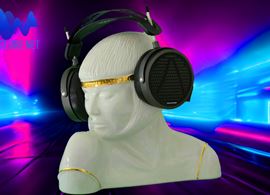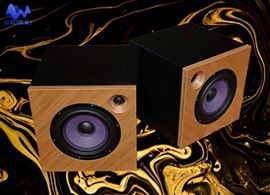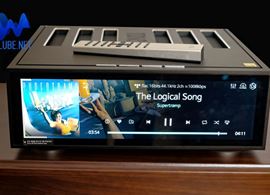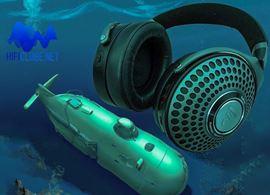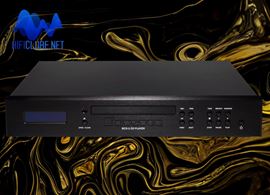Note: read original review in Portuguese here.
Disclaimer: what you are about to read is not a mundane audio review. It is a love letter, as ridiculous as all love letters are, according to Fernando Pessoa, a Portuguese poet.
To Hervé Delétraz, for his love of music
In the age of streaming amplifiers with internal DAC, asking 31,500 euros for a pure analog integrated amplifier (even the Phono stage is optional), may seem excessive.
But DarTZeel CTH8550 MkII is such a personalized product that it distinguishes not only the man who makes it but also those who listen to it, and especially those who buy it, as persons of exquisite taste.
The creator, Hervé Delétraz, is himself an eccentric and, albeit being Swiss, there is nothing cautious about him. On the contrary, he is a cheerful, playful person with captivating energy founded on the conviction that an amplifier is not what you measure but what you hear. And he uses the minimum of components in the signal path to achieve just that.
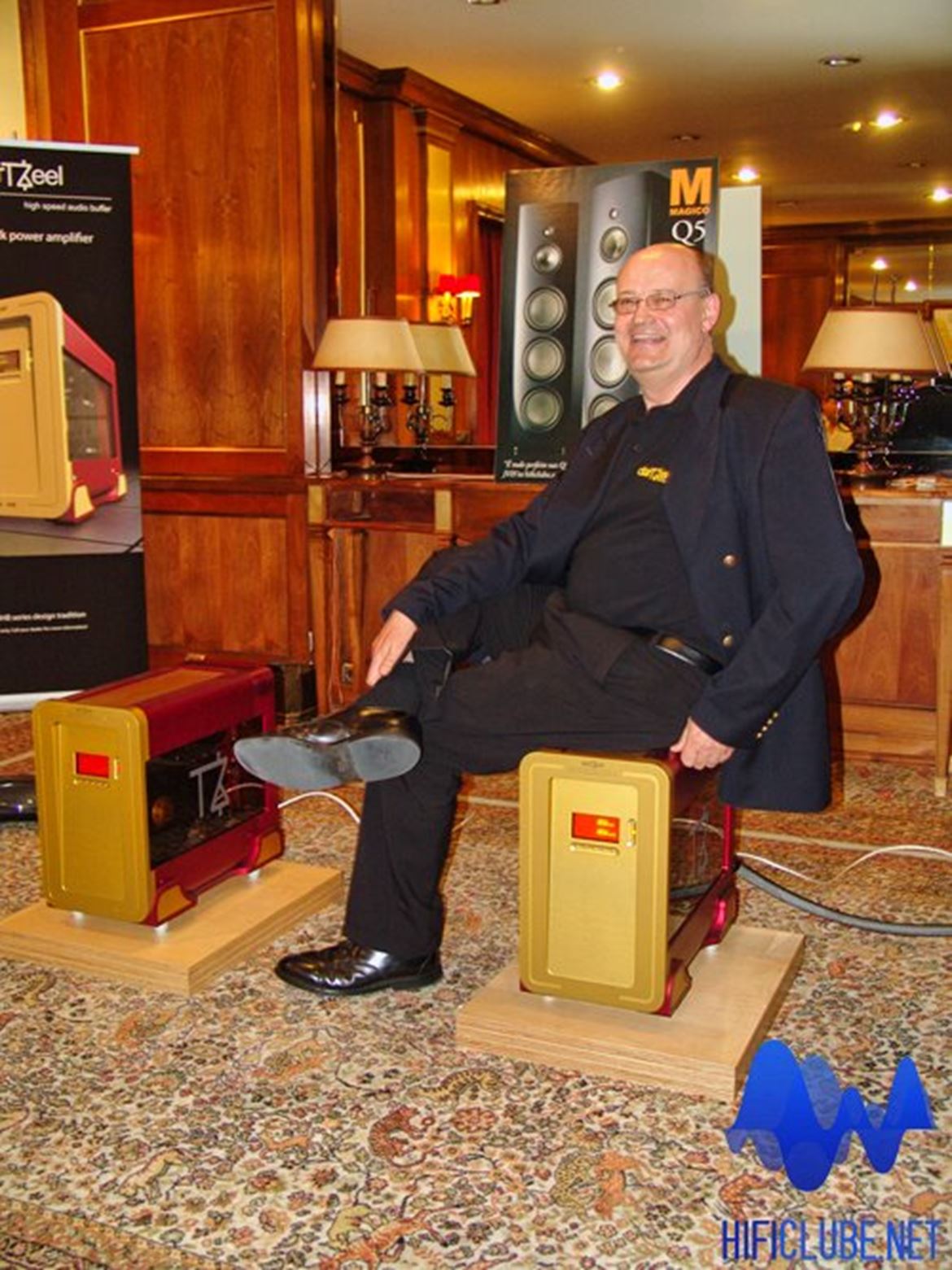
Hervé Delétraz, at the Palácio-Estoril hotel, at the European presentation of the NHB-458 monoblocks. Audioshow 2010.
Or, as Hervé himself puts it:
'Not everything you measure has any influence on the quality or personality of the sound. With 40 years of experience, we know which measurements really count. And those are the ones that let the emotion of music listening come through. It is not by chance that CTH stands for 'Close To Heaven.'
Interview with Hervé Delétraz (Audioshow 2010/Estoril)
DarTZeel CTH-8550 II is a solid-state amplifier, with a reasonable (by Switzerland standards) but arguably high price, with at least 85% of the quality of the NHB-108 stereo amplifier, and the same 'valve sound,' without the linearity problems and drawbacks of vacuum technology that paradoxically has continued to captivate audiophiles for decades, despite the 'measurements' proving otherwise.
Nevertheless, it offers more than a simple illusion of the acoustic perfection of the NHB-468 monoblocks, recently used to power the Wilson Audio Alexx V, at the European premiere, which took place in Porto, Portugal.
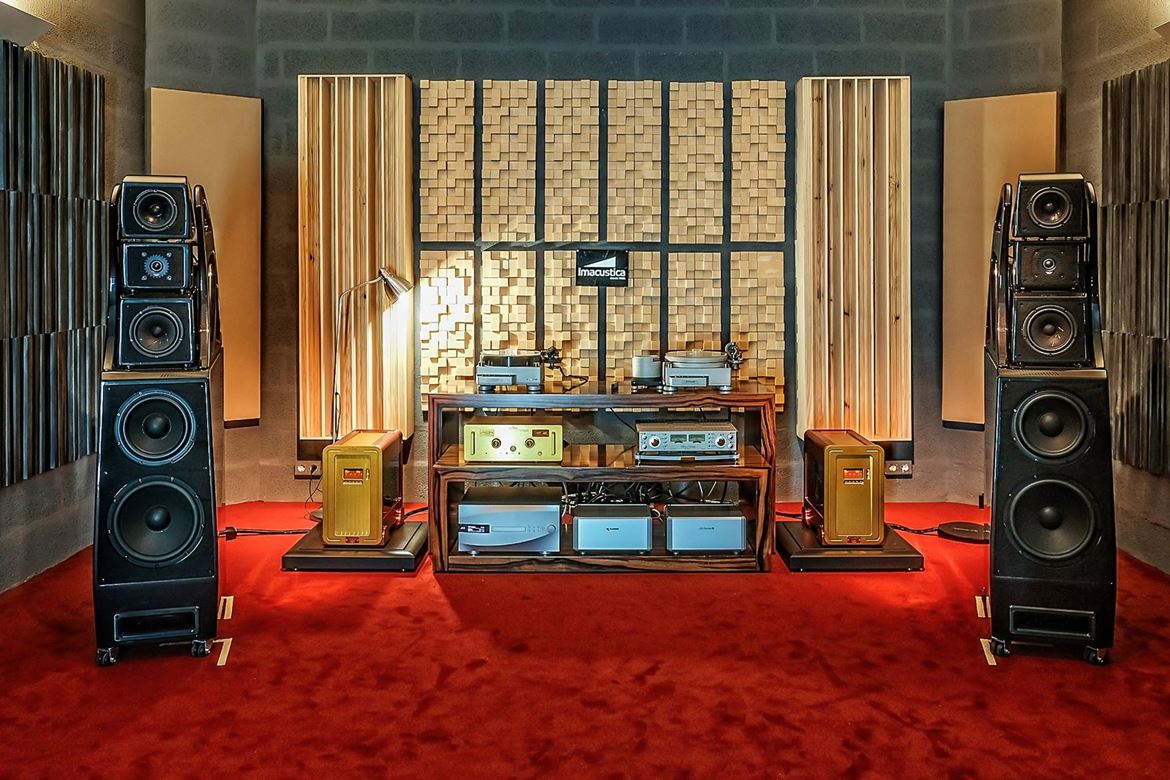
DarTZeel NHB 18NS MkII (preamplifier)+ NHB 468 (monoblocks) powered the Wilson Audio Alexx V in the European premiere at Imacustica - Porto
'DarTZeel never releases a product without first conducting lengthy listening sessions. If there is something that doesn't seem to conform to our quality parameters, we go back to the drawing board until we find the solution, even if we have to use measuring equipment as well. Between listening and measuring, we believe more in what our ears are telling us'. Hervé explains.
If you believe in today's scientific gurus, who shield themselves behind Audio Precision measuring equipment, to conclude and inculcate those conclusions into the heads of believers that you can only hear what you measure, this amplifier is not for you.
And it would have been so easy to follow the trend by just resorting to global negative feedback to improve some of the electrical parameters. But there you have it: negative feedback and sound quality are incompatible.
Hervé Delétraz only takes advantage of his engineering training to contribute to taking us to the heart of music, following Goethe's philosophy:
Man himself, insofar as he makes use of his senses, is the greatest and most exact physical apparatus that exists.
'In music, only the human being can be a judge. Theoretical physics can never explain why our soul is touched by divine grace. First, you listen, then, yes, you try to confirm with measurements what you have heard - never the other way around. This is how all our musical instruments are designed', Hervé continues.
That reason alone qualifies DarTZeel and Hervé Delétraz to integrate the Absolute Sounds ‘Ten Collection’, along with Robert Koda, John Devore, and Franco Serblin.
As absurd as the analogy may sound, an Audio Precision system would allow the conclusion that a sea bass freshly angled in the Guincho sea and another of the same species bred in captivity taste the same. They don't.
Hervé knows now how to distinguish both, as he proved at lunch in Porto de Santa Maria (a famous restaurant in Cascais, Portugal), in 2010, at the time of the Audioshow, then held at the Hotel Palácio do Estoril, where we were served a tasty, steaming wild sea bass. Hervé was delighted: it tastes like the sea, he said, in the same way, that my amplifiers taste like music.
It is not by accident that 'savvy' and 'savour' have the same etymology in Latin.
What seems to be merely a product of the Swiss precision metal-mechanics industry is given luxury status by the front panel while adding a touch of poetry: Pleasure Control, in place of the more prosaic Volume Control.
All DarTZeels ought to be red like Ferraris!
The red colour of the casing, which flows to the interior, might be a concession of dubious taste for some, perhaps even a little kitschy, especially in contrast with the gold panel. You can opt for black, of course. But the gold-red visual is the distinctive hallmark of a DarTZeel.
And anyone who pays €31,500 for an integrated amplifier at least wants others to know with a glimpse of an eye it is a DarTZeel. I think whoever opts for black will regret it because 'ça n'est pas la même chose' (It's not the same).
Note: Hervé informed me that DarTZeel has stopped producing the black version of the CTH-8550, since 2012 because demand was extremely low after all – less than 3% of units sold. The truth is I never saw a black DarTZeel; I just thought they were still available.
On the other hand, I could well do without the 12 steel screws that fix the lid, which I see as an aesthetic provocation, shocking even because they are not flush to the surface of the top plate, and thus it all seems like an afterthought. As if I didn't know that at DarTZeel everything is thought over and planned with due care. For example, that these particular screws and their special arrangement might be the best way to control the resonance of the lid.
I admit it even makes it look like a strongbox, an idea the handles help to reinforce. The solid aluminum front panel looks like a gold ingot, like the ones kept secret in Swiss banks. And I could really use one right now to buy the DarTZeel CTH-8550 II.
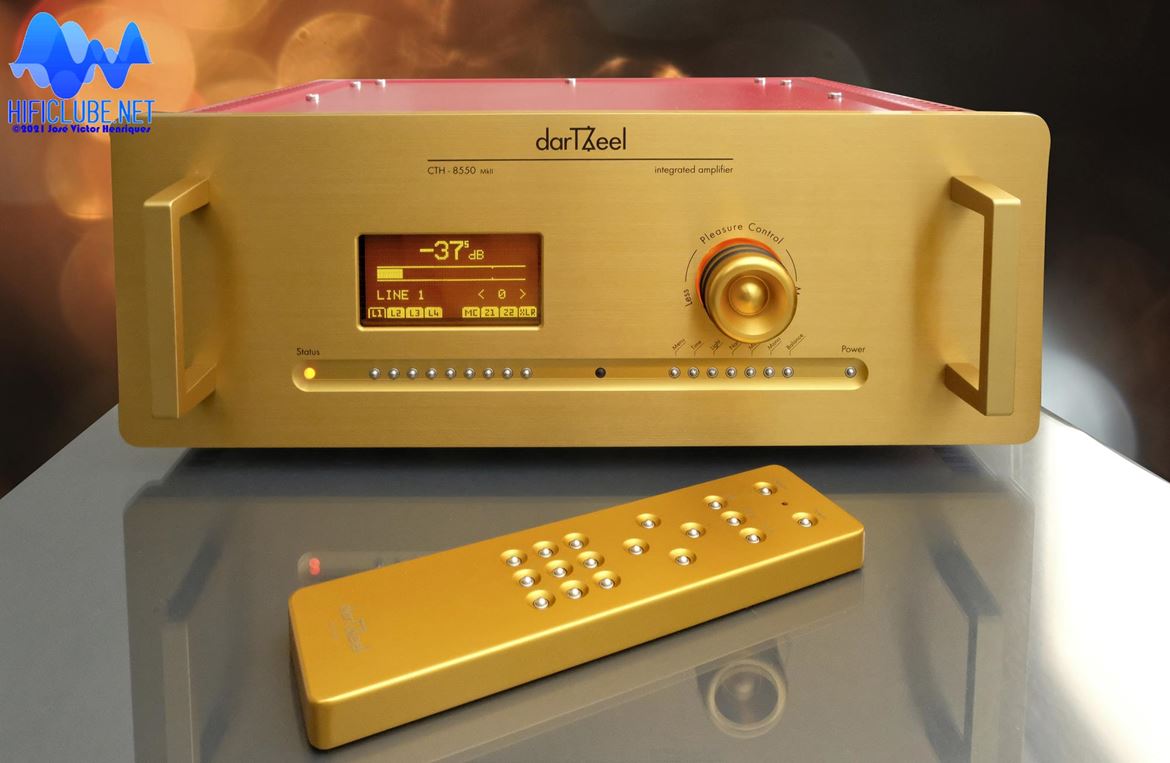
DarTZeel CTH-8550 II, high precision metalwork with laser cut
...it even plays well at a low level maintaining all the harmonic structure and tonal balance without the bass losing its gravitas...
The front panel is dominated by the dial and the volume rotary knob, with non-slip rubber rings, ironically named Pleasure Control, that contradicted the first thought that occurred to me when I used it: how lovely that it even plays well at a low level maintaining all the harmonic structure and tonal balance without the bass losing its gravitas.
Thus, the pleasure does not stem only from getting high on volume (pun intended) but also from touching and rotating the knob, which causes a tactile frisson in your fingers.
In the previous 18NS, the source selector was called Enjoyment Source, here replaced by 9 tiny push buttons that do not trigger the usual relays but instead activate LDRs (light dependent resistors).
The buttons are too small and have no identification. I realized later that the individual labelling is on the display. Therefore, the lettering would be redundant. And nothing on a DarTZeel seems redundant.
However, the row of buttons below the volume control is duly identified (see photo), which is logical because they are to be used together, with all the information appearing on the alphanumeric display.
There are dozens of functions, which can be learned in the manual (download from the DarTZeel website), and I'm not going to waste time with it because I'm too busy listening to music.
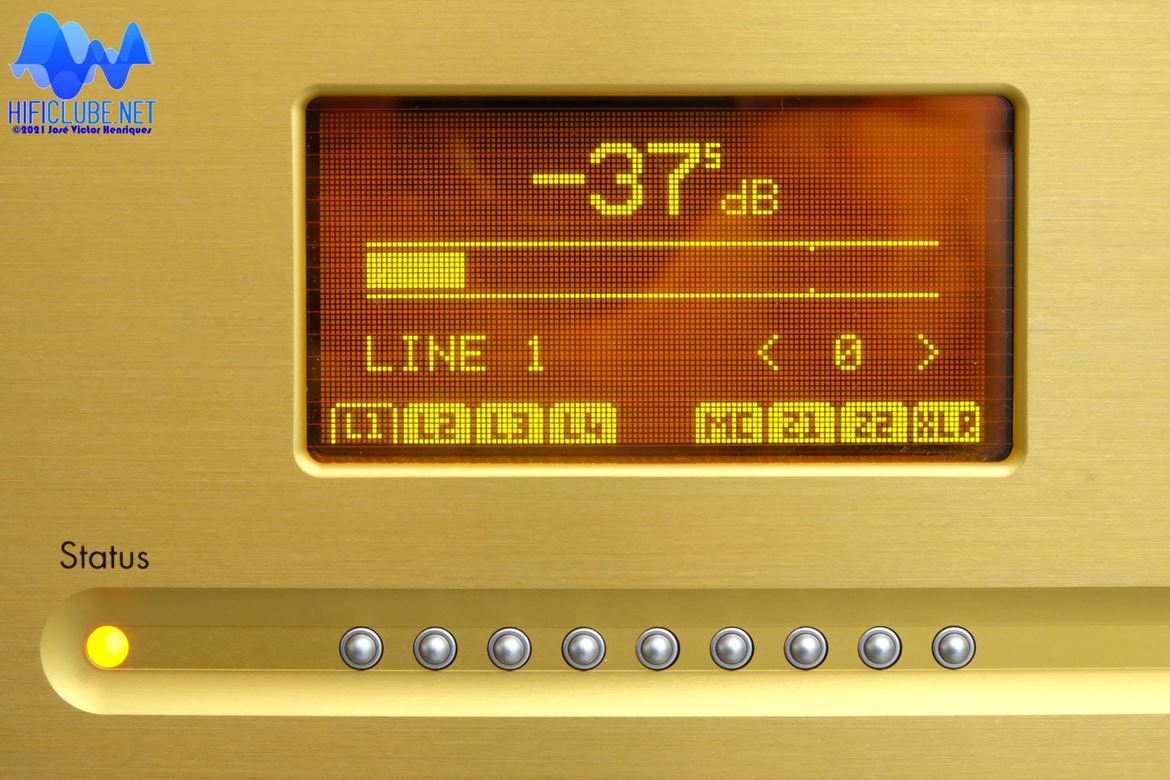
DarTZeel CTH-8550 II, alphanumeric plasma display
Furthermore, the remote control gives you direct access, so you don’t have to take a crash course to learn all the functionalities. I just found it intriguing that a €29,000 high-end integrated amplifier also had an 'alarm clock'. Ah, Hervé is Swiss and just couldn’t help it!...
Other than the heavy and golden remote control, each CTH-8550 II comes with a USB flash drive, on which the owner's serial number and access code are registered, as well as other parameters such as operating voltage and installed firmware, from a .dtz file that you download from the DarTZeel website. But only after proving that you are the rightful owner. Ils ne sont pas fous ces suisses!...
So don't be fooled by the USB inputs on the rear panel: the CTH-8550 II has no digital functions: DAC, Streamer, or whatever.
In my case, the code was already installed by Absolute Sounds. And Imacustica (Portuguese distributor) registers it in your name when you buy it, of course. If it didn't, it would play for 15 minutes and then shut up forever, or until it was officially reactivated.
Moral of the story: if anyone is thinking of stealing a DarTZeel, think again, it won't do you any good, and it weighs 30 kilos!...
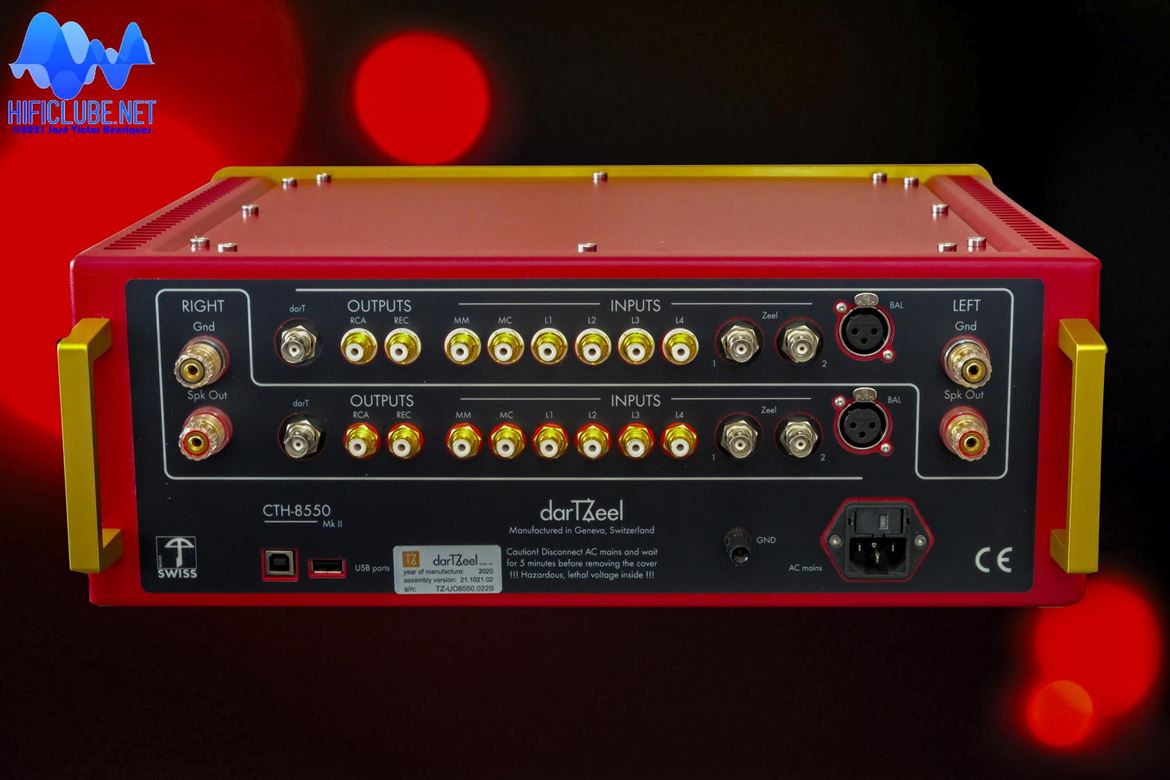
DarTZeel CTH-8550 II, rear panel
The rear panel layout is perfect with 6 RCA + 1 XLR inputs and 2 BNC exclusive Zeel 50 Ohm inputs to connect to other DarTZeel equipment, like a preamplifier, which doesn't make much sense. But it's there anyway if you need it. Outputs: RCA, REC, and BNC, when you want to use the CTH-8550 II as a preamplifier, which makes a bit more sense, maybe. The speaker terminals are WBT of excellent quality.
When you buy it, before you take it home, ask to have it opened, because this beautiful Swiss 'landscape' is worth seeing, although it may seem strange to you that the small transformer for the preamp power supply is mounted 'piggybacked' on top of the power stage transformer.
A distinctive feature of the DarTZeel NHB is the gold plates that connect the capacitors, which look like a traditional Swiss Alpine lace. But the CTH-8550 capacitors are mounted laterally on circuit boards instead. Not so pretty…
The output stage topology is based on just 2 + 2 bipolar transistors mounted in parallel, with a minimum of components in the signal path, but still capable of outputting over 200W/8 and 330W/4, without recourse to global negative feedback, very much in line with Nelson Pass's minimalist designs.
The CTH-8550 II works in Class AB (20W in Class A). However, it does not dissipate much heat, unlike the NHB 108, even though the sound is typical of a pure Class A amplifier.
All components are isolated from the chassis through insulation rubbers to eliminate vibrations.
What has changed from MkI to MkII? Very little
The new MkII version is very similar to the original CTH-8550, and Hervé is very discreet about the improvements made, which have mainly concerned the isolation of the transformers, immunity to radio frequency interference, and the power supply, in a (successful) attempt to lower even further the silence threshold, which was already ghostly on the original.
When you reach this level of quality and price, it becomes difficult to find practical justifications that make sense to the average audiophile.
It’s time to let in the social media trolls with their comparisons of cheap and expensive cars, which all have four wheels and arrive all at the same time; with watches, that give you the exact time no matter the price; with wines, or even 'sea bass' (mea culpa), in short, all commonplaces, only to escape debating what really matters.
Sometimes, they even advocate in social media that instead of a DarTZeel you should buy a Chinese integrated on the internet for 400 euros, which some YouTube' scientist' says has 'perfect measurements,' therefore it must have a more-than-perfect sound. And that everything else said about highend audio is fake news.
And the DarTZeel is not even remotely the most expensive integrated you can buy. So the question is: why should you buy this one and not another?
Personal experiences can not be conveyed by just writing them down. For example, how can we explain love? Does having the loved one analyzed in a laboratory make her/him more compatible with you? *
*Such is at least the theme of a Netflix series, 'The One', that has everything to go wrong. I've only seen two episodes, but I can guess the outcome.
Love is born from us living together. From understanding each other. From sharing. From being happy as a couple. It's a physical thing, but also chemical. It is feeling good in the presence of your loved one, as opposed to the absence that hurts.
Pleasure Control: to love is to be able to touch, to feel - not just to control...
That's what I felt with the DarTZeel CTH-8550 II. From the time it came home until today we were always together: it played all day long, every single day.
I connected it to Roon, via a Wattson Audio Streamer, and let the Roon guide me across multiple musical landscapes: from classical, especially the Baroque period, focusing on Isabelle Faust's interpretations, to the old rock of Eric Clapton and the Eagles; from Dua Lipa's pop to jazz from Coltrane and Mulligan, not forgetting crooners such as Sinatra, Dean Martin, and Brel.
...I can't find fault with the CTH-8550. It just lets the music come through unhindered! ...
I also listened to CD and SACD, of course. And many high-resolution files via Hugo 2. I have not used LP for many years, although I admit that it is still the absolute reference in certain circumstances, along with the 15ips magnetic tape. So, your experience with LP can only be better than mine.
I can't find fault with the CTH-8550 II. It just lets the music come through unhindered. And isn't that what you are looking for when you invest €31,500 in an amplifier? That it ends the constant craving for change?
And isn't that what love should be when others no longer attract us because we have found our soul mate, and we are finally happy? DarTZeel is my soul mate. At least until the day it leaves my home, which will be soon, hélas.
It is not necessary to end this unorthodox review by saying I listened to this record or that other one because the music as a whole always made sense to me.
... the CTH-8550 II doesn't let itself be easily defined. It's everything and nothing at the same time...
Splitting music into bass, mid and treble, micro and macro dynamics, textures, and lines of definition, or virtual soundstages would be a crime of violation of privacy because the CTH-8550 II does not let itself be easily defined and does not like to be analyzed. The DarTZeel CTH-8550 II is everything and nothing at the same time because it does not impose itself. It’s there for you. Just listen to the music and forget the electronics behind it.
How on earth do you define an integrated amplifier that is full of colour, and yet does not have any colouration; that is joyful without being too vivacious; dark quiet, yet bathed in inner luminosity; transparent without being analytical; powerful and smooth like a good giant, that never hurts the music but always protects it; fast but never in haste; authoritative but condescending and consensual whenever the musical process demands it?
If everything I've written means nothing to you, or you consider it to be just reviewer’s 'bullshit' (all love letters are ridiculous), don't buy the CTH-8550 II.
If, on the other hand, you understand the feelings I am trying to convey to you in writing, at least listen to the CTH-8550 II at your local distributor.
But beware: like me, you'll be under DarTZeel’s love spell. And no filter or potion can make it disappear...
Note: English translation revised and adapted by the author from the original review in Portuguese published on Hificlube.net in May 2021

